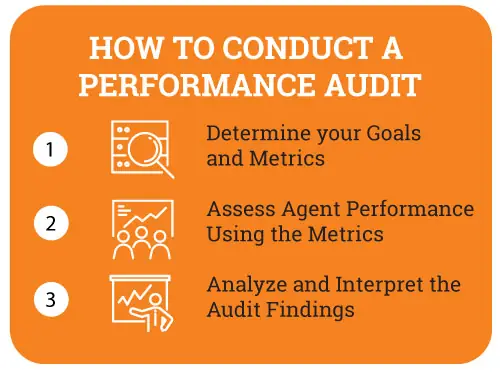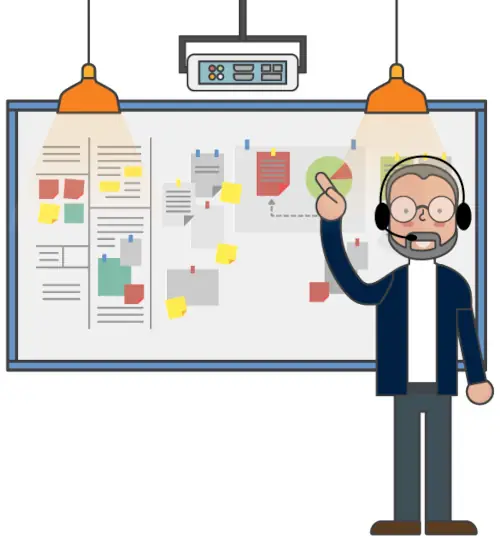Coaching plans provide a framework that offers agents clarity, consistency, and opportunities to improve within their roles. The benefits of applying an effective coaching program far outweigh the time and effort invested. For example, coaching plans enhance agent performance, facilitate a culture of continuous learning, and lower agent turnover rates.
However, creating a personalized and effective coaching plan requires understanding the unique skills and abilities each of your agents possesses. The best way to figure this out is by performing a performance audit.
What Is a Performance Audit?

A performance audit is an evaluation tool used to compare a team's or individual employee's current skills and capabilities to benchmarks within an organization or industry. Particularly in call centers, it serves two key roles. First, it identifies your agents' strengths and the areas where they excel. Second, it exposes the areas they need to improve.
With this information, you can meticulously create a coaching plan that will lead to your call center agents' development and performance improvement. Areas evaluated may include communication, teamwork, technical proficiency, problem-solving, time management, and customer service skills.
Skills Audit vs Performance Audit
Even though skills audits can generally be used to supplement performance audits, there are still key differences between the two. Performance audits focus on KPIs such as FCR rate, AHT, and Csat Score, whereas skills audits focus on more subjective metrics such as technical and soft skills, certifications, and qualifications.
Skills audits are considered a grey zone because the results are more subjective since they are not benchmarkable. On the other hand, performance audits can be benchmarked since they focus on KPIs that are standardized throughout the industry.
How to Conduct a Performance Audit

Carrying out a performance audit requires a robust plan. Identify the key metrics necessary for obtaining your call center performance goals. These skills may include problem-solving, active listening, communication, and technical know-how. Next, assess each agent's proficiency in these areas through self-evaluation, peer review, and objective evaluation methods such as supervisor observation or center call recordings. Finally, analyze and interpret the audit findings, identifying agents' strengths and areas needing improvement.
The first step to conducting a performance audit is determining your call center performance goals and the metrics needed to evaluate whether these goals have been reached. For example, if your call center's goal is to improve First Call Resolution (FCR) by 15% within the next quarter. Key metrics, such as FCR rate, Average Handle Time (AHT), and Customer Satisfaction (Csat) score, are identified to evaluate the achievement of this goal.
Establishing agent goals and metric targets should involve team collaboration. If agents aren't actively engaged in this process, their commitment to achieving the Csat performance goal may be lacking. Therefore, reaching a consensus on agent goals and associated metric targets is crucial to fostering commitment, ensuring that these objectives are both realistic and achievable.
After finalizing the call center performance goal and agreeing on the appropriate metrics, the next step is to discuss and formulate a plan of action to achieve the set goal.
Once the call center performance goals and metrics have been established, the next phase involves assessing agent performance based on these identified metrics. This step is crucial for gaining insights into the current proficiency levels and determining the areas that require improvement.
Begin by collecting data related to the chosen metrics. For example, measure metrics such as FCR rate, AHT, and Csat score because they directly relate to the goal of improving FCR by 15% in the next quarter. Analyze individual agent performance against these metrics to identify strengths and weaknesses. This assessment should be conducted objectively, clearly showing how well agents are meeting the established goals.
After assessing agent performance using the established metrics, the next crucial step in conducting a performance audit is to analyze and interpret the findings. This involves a comprehensive review of the collected data to draw meaningful insights and make informed decisions regarding skill development and performance enhancement.
Identify patterns and trends within the audit findings. Are there consistent challenges or successes across the team? Pinpoint specific skill gaps that may be contributing to performance discrepancies. It's essential to understand the root causes behind any shortcomings and recognize exemplary practices that can be shared among the team.
Performance Audit Template
An excellent example of a performance audit template is the mySQM™ QA Scorecard.
SQM group has conducted hundreds of quality assurance case studies with leading North American company call centers. SQM's research shows that a whopping 81% of agents' QA scores did not correlate with Csat resulting from traditional QA scorecard evaluations.
The low correlation between traditional QA and Csat scores is because the wrong metrics and weighting are used to evaluate the call, and the customer's viewpoint (e.g., post-call survey) is not used as part of the QA evaluation of the call.
Conversely, the mySQM™ QA scorecard Csat correlates highly to QA scores.
The main reason for the high Csat and QA score correlation is that the QA evaluation form includes call handling, call compliance, and post-call survey metrics. Call handling and call compliance metrics are evaluated by AI, whereas post-call survey metrics are judged by the customers themselves. Furthermore, the metrics are weighted according to Csat correlation.

How to Create a Coaching Plan From a Performance Audit
A coaching plan is essential for fostering agent development and enhancing performance within any call center. To increase effectiveness, such a plan should be rooted in the results of a comprehensive performance audit.

1. Set Clear and Specific Goals based on Performance Audit
The initial step in creating a coaching plan is goal setting. The performance audit results provide critical insights into each agent's capabilities and areas of weakness. Armed with this knowledge, establish clear, specific, and realistic development goals personalized for each agent. These could range from improving customer service skills to enhancing technical proficiency.
For instance, if the audit highlights a challenge in maintaining a balance between minimizing AHT and ensuring high Csat scores, a development goal could center on refining time management and communication skills. Agents may be encouraged to undergo communication training or workshops tailored to streamline interactions without compromising service quality.
2. Develop an Action Plan for Individuals or Teams
After setting clear goals, it's time to construct robust action plans. This involves specifying pathways for improvement for each individual or team involved. Outline specific actions, the resources needed, training to be undertaken, and the key performance indicators to monitor progress.
For example, to address the challenge identified in the performance audit concerning the balance between minimizing AHT and ensuring high Csat scores, the following action plan could be proposed:
- Conduct individual assessments to pinpoint each agent's specific time management and communication hurdles.
- Develop customized training plans focusing on workshops to enhance communication skills and time management training to improve task prioritization.
- To complement this, a mentorship program will pair experienced agents with those seeking improvement, fostering a collaborative learning environment.
- Key performance indicators such as AHT and Csat scores will be closely tracked on an individual basis, with periodic assessments to gauge the practical application of learned skills.
These plans should be flexible and adaptable, accounting for the varying progress rates and unique learning curves of different individuals or teams. Regular reviews can ensure that the action plans stay effective and aligned with evolving business goals and operational demands.
3. Communicate the Coaching Plan to Agents
The kick-off point is transparent communication. Each agent needs to understand their role in implementing the coaching plan. Clearly define the purpose, objectives, and expected outcomes, and deliver your message in a clear, understandable, and persuasive manner.
Don't forget to set milestones and give a timeline for completion. Additionally, providing a platform for feedback and queries provides an environment for interactive conversation, which will undeniably result in more engaged and enthusiastic participants.
For example, if your goal is to reduce AHT by 15% while maintaining high Csat scores in the first quarter, you can meet with your agent to discuss what that means and how it can be achieved. You can set milestone markers such as improving AHT by 3%, 6%, etc. Don't forget to encourage agents to ask questions or give feedback.
4. Provide the Necessary Resources and Support for Agent Development
Resource provision is crucial for sustained growth. Equip your agents with the tools, training programs, guides, and reference materials they need to excel. Further, ensure a support structure is in place for monitoring progress, spotting developmental areas, and extending due recognition for achieved milestones.
For example, include a budget allocation for external training and access to online materials, along with regular feedback sessions to monitor progress.
Remember: the actual accumulation of skills is the collective responsibility of both the agents and the management. So, invest time and resources in mentorship programs, encourage self-paced learning, and foster a culture that celebrates continuous learning and improvement.
5. Monitor and Re-Evaluate the Coaching Plan
Teaching and mentoring your agents are half of the task. The other half rests on efficiently monitoring and evaluating the coaching plan you've implemented.
Implementing regular check-ins and feedback sessions is instrumental in maintaining the momentum of your coaching plan. Regular touchpoints allow you to stay connected with your team and provide the necessary guidance as the program unfolds. They:
- Provide the opportunity to work through budding issues before they escalate.
- Enable open and effective communication.
- Foster rapport between the supervisor and the agent.
- Keeping a record of your agents' performance before and after the coaching plan's implementation is imperative. This might involve analytics such as
- First call resolution rate: Has this metric improved?
- Customer satisfaction scores: Are your customers happier with the service they're receiving?
Moreover, assessing whether the coaching plan has led to new skill acquisition is vital. Are your agents more adept at using your call center's software? Are they demonstrating better soft skills, like empathy and active listening? These are essential questions in evaluating the impact.



